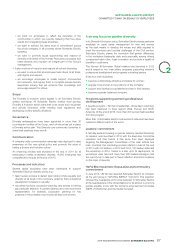APC 2015 Annual Report Download - page 99
Download and view the complete annual report
Please find page 99 of the 2015 APC annual report below. You can navigate through the pages in the report by either clicking on the pages listed below, or by using the keyword search tool below to find specific information within the annual report.
2015 REGISTRATION DOCUMENT SCHNEIDER ELECTRIC 97
SUSTAINABLE DEVELOPMENT
2
SCHNEIDER ELECTRIC, AN ECO-CITIZEN COMPANY
the «Village Level Entrepreneurs» model to allow its entrepreneurs
to add a solar product distribution service to improve their income.
The program guarantees them a logistics network necessary for
their activity and provides them with technical and entrepreneurial
training throughout the subcontinent. Based on this success, in
2014, Schneider Electric partnered with Golden Key Company
(GKC) in Myanmar to form « Village Electrifi cation Consultants »,
which establish their point of sale of energy access products in their
villages, advise villagers on domestic electrifi cation and provide
maintenance of installed products.
Decentralized rural electrification: Rural electrifi cation continues
following the success of the projects launched since 2009 in
Madagascar, Vietnam, Senegal, Cameroon, Egypt and Brazil.
Schneider Electric provides expertise to municipalities for defi ning
energy needs, sizing electrifi cation solutions, mobilization of local
partners for installation, and training of maintenance and after-
sales service agents. Schneider Electric set up off-grid solar
power stations that powered community buildings and charging
equipment. All micro-units are managed by an entrepreneur located
within the community and trained by Schneider Electric to ensure
maintenance and economic viability in the long term. In 2014, the
village of Baghagha in Casamance, Senegal, was equipped with
two Villaya Villasol micro solar power plants that provide electricity
to the school and the health center, and a battery charging station
for lighting and cell phones in domestic households. In 2014,
Schneider Electric partnered with Golden Key Company (GKC) in
Myanmar to electrify three villages in the province of Irrawady. Some
800 households have been electrifi ed through an experimental
microgrid solar solution, all with direct current that enables them to
power two LED lights, a cell phone charger and a radio 24hours
a day. In 2015, Schneider Electric was involved in the electrifi cation
of 60 villages in Indonesia as part of a government program. Micro-
networks with 15 to 75kW in power supply each village consisting
of 80 to 520 households. In the same year, Schneider Electric also
electrifi ed 128 schools across Kenya. Solar electrifi cation solutions
can be customized for each school and can power up to 30
computers to facilitate the teaching process. At the same time, the
success of the fi rst village electrifi cations in the province of Ogun in
Nigeria, has given rise to a collaboration between Schneider Electric
and the company Arnergy Solar Limited to electrify new villages in
the province of Osun. Thanks to the support of the Bank of Industries
and the UNDP, the partners are implementing economically viable
and sustainable solutions, particularly thanks to the installation of
pre-paid meters in each of the homes and businesses connected
to the micro-networks.
Training
Approach
The key challenge of training in the energy sector is to provide
underprivileged people with the knowledge and skills to be able to
carry out a trade in a safe and responsible way, providing them and
their families with the means for satisfactory subsistence.
It will also give them the ability, should they wish, to sell and maintain
energy access offerings and to create their own small business in
time.
Furthermore they are a vital and indispensable element for all
responsible and sustainable rural electrifi cation policies.
Schneider Electric’s strategy for training underprivileged populations
in the energy sector includes three key priorities:
• basic training over a few months, which is free and accessible to
a large number of people, and adapted as much as possible to
the local situation ; these training courses lead to the issuing of a
certifi cate of competence by Schneider Electric;
•single or multi-year training leading to qualifi cations, in partnership
with local Ministries of Education, if not included within a bilateral
logic;
•the training of trainers to support the effective and quality roll-out
of training down the line.
These actions are always implemented in partnership with local
players and/or national or international non-profi t organizations
(NGOs, governments, etc.). They systematically work with Schneider
Electric’s local subsidiary. The actions may be accompanied by
funding for investments in materials and missions of the volunteers
of the Schneider Electric Teachers association, which, if the need
arises, enable the transfer of expertise.
Constantly evolving to meet the needs of the professions and
solutions of tomorrow, the range of teaching materials launched in
2012 was expanded to include new materials. The fi rst center of
excellence for the training of trainers was opened in India in June
2014, in partnership with the French Ministry of National Education.
Two international agreements were signed this year; the fi rst with the
company Cummins and the second with NGO Don Bosco Mondo.
Efforts to identify potential global partnerships will continue in 2016.
Entrepreneurship is now part of training. These specifi c training
modules are designed to be rolled out quickly in all Access to
Energy partner centers.
Since starting the program in 2009, more than 102,000 people
have been trained in more than 25 countries, giving hope for decent
standard of living for the young people being supported.
Outlook
The large-scale expansion of the training projects initiated in 2013
will continue, with the objective of training 150,000people by 2017
and the goal of supporting 1million young people by 2025.
The opening of new centers of excellence is planned in partnership
with the French Ministry of National Education.
In 2016, the following activities will be launched or are being
continued: the launch of new projects in new countries, initiatives
for direct donations of materials, transnational spin-offs, the
development of global partnerships, creating alumni, and research
on digital learning solutions.
























